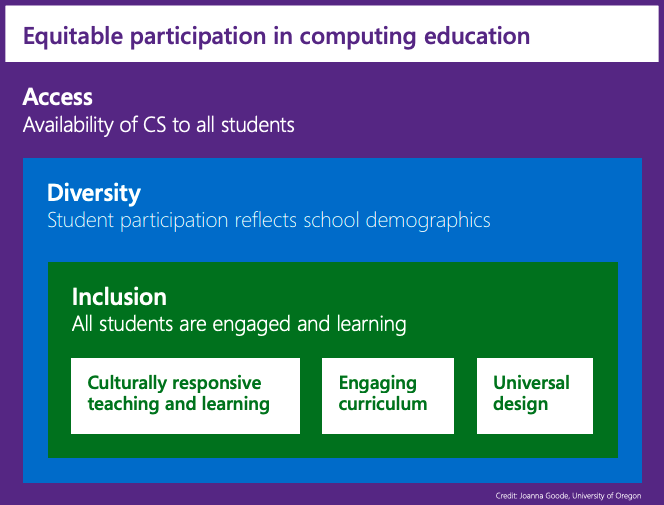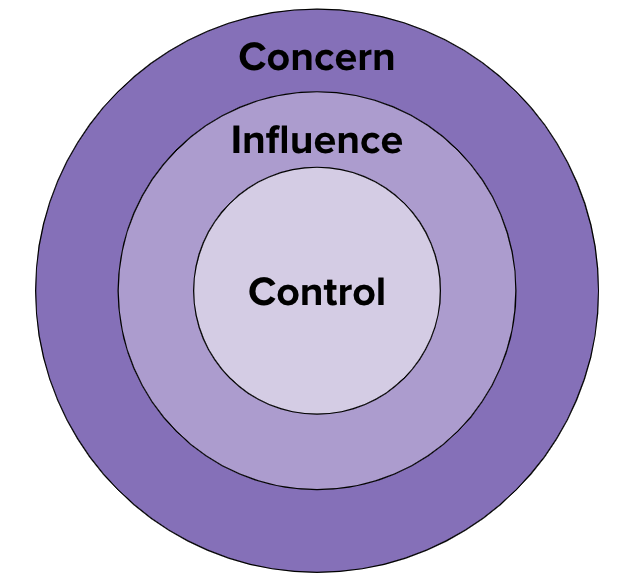Session 2: Recruiting Students to Your CS Principles Classroom
30 minutes
discussion-based
Purpose
We want teachers to know that there are concrete things they can do now to influence who takes their class next year. Teachers are key stakeholders in addressing the equity gap in CS; this session is designed to help teachers see themselves as playing a role in the recruitment process.
Objectives
- Participants can identify systemic barriers that limit access, diversity, and inclusion in CS education.
- Participants will list strategies to gather data (quantitative and qualitative) about access, diversity, and inclusion in CS courses locally.
- Participants will analyze access, diversity, and inclusion data from school and classroom to create a recruitment plan.
Supplies & Prep
Workshop Modality:
- Whole group
- Breakout rooms
Facilitator Supplies:
- Virtual Module 4 - CSP 21 - 22 - Slides - Slides
- Slide setup:
- If you are working with a regional group of teachers (ex. from a specific state), consider adding state-specific slides to the statistics section of this session.
- In this session, each participant gets their own slide to work with. We put twenty slides in the presentation, but if your group is larger than twenty, you may need to add more slides.
Participant Materials:
- Journals
Agenda
Thinking About Goals and Gaps (7 minutes)
Gathering Data (10 minutes)
Make Your Recruitment Plan (13 minutes)
Facilitation Guide
Thinking About Goals and Gaps (7 minutes)
Facilitator Tip
Some participants may be in a context where they do not need to recruit because every student takes their course. If this is the case, consider having them shift to thinking about retention in their school’s CS program overall, such as enrolling in a future CS course. These participants can also participate in this activity through the lens of, “What can I do to remove barriers that limit access to CS classes in my school?”
(2 minutes) Set Context
Producer support: Prepare to put participants in groups of 2 for 3 minutes.
💷 Remind participants of the equity cycle, and that the work is ongoing throughout the year to bring access, diversity, and inclusion to their classrooms and schools. Share that during AYW 2, they will be understanding context more deeply to effect change.
Remarks
In this session, we’ll be talking about the barriers that limit access, diversity and inclusion in CS education, both broadly and within your classrooms. In order to understand the context, we’ll be brainstorming how we can gather and analyze data to create a recruitment plan for your classroom next year. It might seem far away right now, but we know registration happens soon!
Before we get started, let’s talk about how we define access, diversity, and inclusion so that we have a common language to talk about recruiting.
💷 Review definitions of access, diversity and inclusion from the Microsoft Guide to inclusive computer science education.

(3 minutes) 💷 Think-Pair-Share
- Thinking about your school and classroom, who is represented in the school, but is not represented in your class right now?
- What barriers do students face in terms of taking CSP?
Producer support: Put participants in groups of 2 for 3 minutes.
Facilitator Tip
You can personalize the statistics slides for your region by visiting https://code.org/promote/ to access statistics from your state. This includes information such as how many computer science graduates in your state identify as female and the break down of AP CS test takers by ethnicity in your state. This might help drive home the difference teachers can make in their local context by changing these numbers to represent the state population overall. You can click on your state on the map and then click the button that says "View state fact-sheet" to access this information.
💷 Use the slides to describe the current reality of representation in CS.
Remarks
💷 You can see we have some gaps when it comes to representation in Computer Science. That’s why, when you signed up for this workshop, we asked you to support the recruitment and enrollment of a diverse group of students that represent your school district’s population - you are a crucial piece in the grassroots movement addressing these gaps.
We want to help you develop plans to reach that goal of recruiting students that match your district’s population from an intersectional perspective - meaning we are bearing in mind students’ multiple identities as they relate to your CS classroom. Just as we’ve thought about our own identities before, your students’ identities might include race, socio-economic status, (dis)ability, gender, etc. With this goal in mind, let’s think about the current reality in your building.
Gathering Data (10 minutes)
(10 minutes) Gathering Data
Remarks
To better understand the barriers to access, diversity, and inclusion within your own classroom contexts, let’s narrow in on the types of quantitative and qualitative data that might be useful for you to develop and execute on a recruitment plan.
💷 Quantitative data means the quantity (numbers) of something and might guide the type of school data you collect such as:
- Attendance
- School Demographics
- CS course enrollment
- Assessment scores
Qualitative data provides a description of something that may be observed, but not measured and might guide the type of classroom data you collect such as:
- Learner profiles to get to know students and how they think they learn best
- Home/Family life to get to know students outside of your classroom
- Student self-assessment/reflection to get know what contributes or detracts from your students’ learning
💷 Think-Share
(4 minutes) Prompts:
- What types of quantitative data would you like to see to better understand equity in CS at your school? How might you collect it?
- What types of qualitative data would you like to see to better understand equity in CS at your school? How might you collect it?
(4 minutes) Whole group share out. Capture strategies for collecting student qualitative and quantitative data on a slide.
Make Your Recruitment Plan (13 minutes)
Facilitator Tip
The image shows a visual for the Concern-Influence-Control model. In general, what we are concerned about is much larger than what we can influence and/or control. Likewise, what we can control is smaller than the things we can influence.
(2 minutes) The Concern-Influence-Control Model
Remarks
💷 When thinking about what actions you can take, it can be helpful to think about what your concerns are, what you influence, and what you control.
There might be a lot of things you are concerned about (“Students only have 5 hours in the day, they don’t have enough time in their schedule to take this class”) that you cannot really influence. But there are probably things you can influence (“Special Ed teachers won’t put students in an AP class because they are worried about the homework load”) that you cannot control. And there are things you can control (“My students don’t show their work to their friends outside this class at all”).

(10 minutes) 💷 Develop the Plan
Remarks
Let’s make our plan! Consider what you can control or influence to get students into your class who represent your building at large from a racial, gender, socio-economic, and dis/ability perspective. What are some things you can do in the next 30 days to reach this goal? What are some things you can do in the next 60 days? What are some things you can do in the next 90 days?
(5 minutes) 💷 Write
Have participants claim a slide as their own by putting their name at the top. Have participants use that slide to create their 30-60-90 day plan and what they can control and influence over that time.
(4 minutes) 💷 Share Out
The facilitator selects a share out method of choice. When selecting, think about your timing. If you are running behind, select a quick share out method. If you have extra time, select an option that might take more time but lead to more fruitful conversation.
Share Out Examples:
- Virtual Gallery walk
- Ask for 1-2 volunteers to share a key takeaway
- Facilitator pulls out key ideas to share with the group from the slide deck or from visiting breakout rooms
Remarks
Teachers have a lot to do everyday, and it can feel like there is no time to recruit students, but for us to be able to make progress on building an equitable CS program in our buildings, we need to influence and control what we can to make that a reality.
We will be following up on these plans in our next workshop.